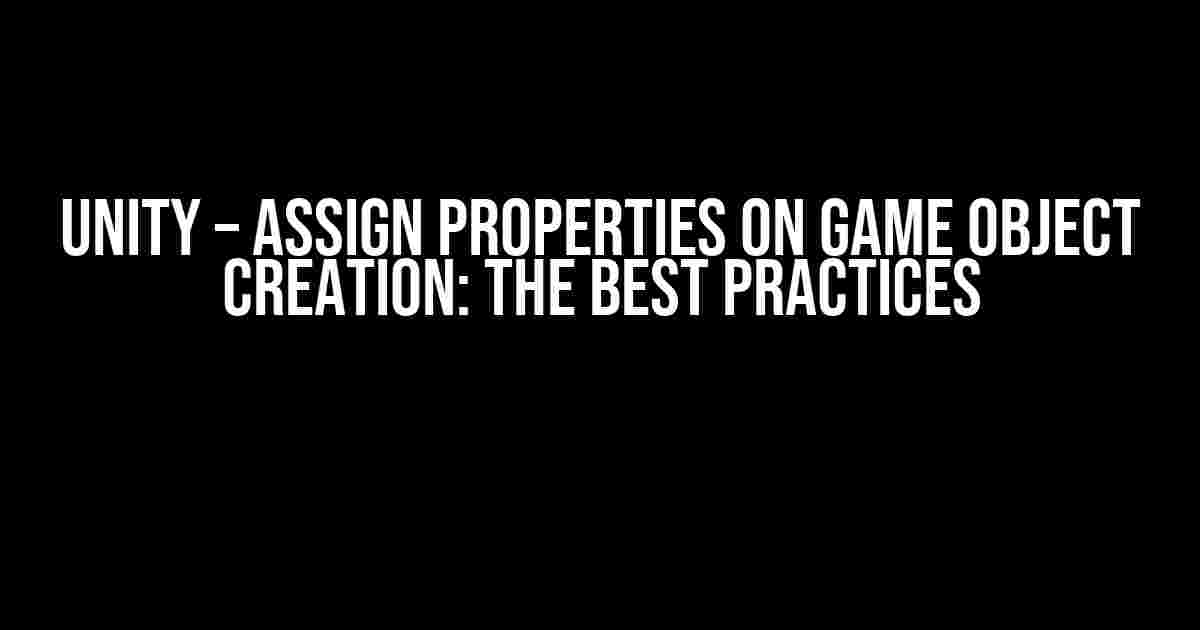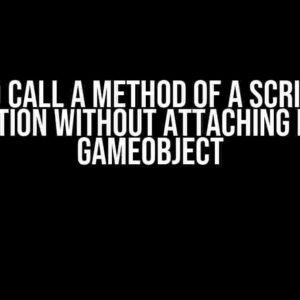When it comes to creating game objects in Unity, one of the most crucial steps is assigning properties to them. This process can make or break the efficiency and performance of your game. In this article, we’ll dive into the best practices of assigning properties on game object creation in Unity, ensuring you create robust and scalable game objects that improve your overall gaming experience.
Why Assign Properties on Game Object Creation Matters
Assigning properties on game object creation is essential for several reasons:
- Efficient Memory Management**: Assigning properties at creation time helps Unity manage memory more efficiently, reducing the risk of memory leaks and crashes.
- Faster Object Instantiation**: Pre-setting properties on creation reduces the overhead of setting them later, resulting in faster object instantiation and improved performance.
- Improved Code Readability**: Assigning properties on creation makes your code more readable and maintainable, as you can easily identify the properties associated with each game object.
- Reduced Errors**: By setting properties at creation time, you minimize the risk of errors caused by incorrect or missing property assignments.
Best Practices for Assigning Properties on Game Object Creation
Now that we’ve covered the importance of assigning properties on game object creation, let’s explore the best practices for doing so:
1. Use the Inspector
The Inspector is a powerful tool in Unity that allows you to assign properties to game objects visually. To use the Inspector, follow these steps:
1. Select the game object you want to create in the Hierarchy panel. 2. In the Inspector panel, click on the gear icon next to the game object's name. 3. In the pop-up menu, select "Edit Script" or "Edit Properties" depending on the type of property you want to assign. 4. In the script or properties editor, set the desired properties and values. 5. Click "Apply" or "Save" to save your changes.
2. Use ScriptableObjects
ScriptableObjects are a type of asset in Unity that allows you to store and manage data. You can use ScriptableObjects to assign properties to game objects at creation time. Here’s an example:
public class MyScriptableObject : ScriptableObject
{
public string myProperty = "Default Value";
}
public class MyGameObject : MonoBehaviour
{
public MyScriptableObject myScriptableObject;
private void Awake()
{
// Assign the property value from the ScriptableObject
myProperty = myScriptableObject.myProperty;
}
}
3. Use Prefabs
Prefabs are reusable game objects that can be instantiated in your scene. You can use prefabs to assign properties to game objects at creation time. Here’s an example:
public class MyPrefab : MonoBehaviour
{
public string myProperty = "Default Value";
}
// Create a prefab instance
MyPrefab prefabInstance = Instantiate(MyPrefab);
// Access the assigned property
string propertyValue = prefabInstance.myProperty;
4. Use a Factory Pattern
A factory pattern is a creational design pattern that provides a way to create objects without specifying the exact class of object that will be created. You can use a factory pattern to assign properties to game objects at creation time. Here’s an example:
public abstract class MyFactory
{
public abstract MyGameObject CreateGameObject();
}
public class MyConcreteFactory : MyFactory
{
public override MyGameObject CreateGameObject()
{
MyGameObject gameObject = new MyGameObject();
gameObject.myProperty = "Default Value";
return gameObject;
}
}
// Create a game object using the factory
MyFactory factory = new MyConcreteFactory();
MyGameObject gameObject = factory.CreateGameObject();
Common Pitfalls to Avoid
When assigning properties on game object creation, it’s essential to avoid common pitfalls that can lead to errors, performance issues, or maintenance headaches:
- Avoid Over-Engineering**: Don’t over-engineer your property assignment process. Keep it simple and focused on the specific requirements of your game objects.
- Watch Out for Property Name Conflicts**: Be cautious when assigning properties with the same name to different game objects. Use unique property names or namespaces to avoid conflicts.
- Don’t Forget to Save Changes**: Always save your changes to the Inspector or script file after assigning properties. Unsaved changes can lead to unexpected behavior or errors.
- Avoid Assigning Properties in Awkward Places**: Avoid assigning properties in awkward places, such as in the middle of a complex algorithm or inside a loop. This can lead to performance issues or hard-to-debug errors.
Conclusion
In conclusion, assigning properties on game object creation is a critical step in Unity game development. By following best practices, such as using the Inspector, ScriptableObjects, prefabs, and factory patterns, you can create robust and scalable game objects that improve your overall gaming experience. Remember to avoid common pitfalls, and always keep your code organized, readable, and maintainable. Happy game development!
| Best Practice | Description |
|---|---|
| Use the Inspector | Assign properties visually using the Inspector panel. |
| Use ScriptableObjects | Store and manage data using ScriptableObjects. |
| Use Prefabs | Reuse game objects and assign properties using prefabs. |
| Use a Factory Pattern | Create objects without specifying the exact class using a factory pattern. |
By following these best practices, you’ll be well on your way to creating efficient, scalable, and maintainable game objects that elevate your Unity game development experience.
Frequently Asked Question
Mastering the art of assigning properties on game object creation in Unity? We’ve got you covered! Check out these frequently asked questions and level up your Unity skills!
Q1: What’s the best way to assign properties to a game object when it’s created in Unity?
A1: One of the most efficient ways is to use a ScriptableObject as a configuration file. This allows you to decouple your property assignments from your MonoBehaviours and make them easily editable in the Inspector. Plus, it makes your code more modular and reusable!
Q2: Can I use a Prefab to assign properties to game objects at creation?
A2: Absolutely! Prefabs are an excellent way to assign properties to game objects. By setting up your Prefab with the desired properties, you can create multiple instances with those properties already assigned. Just remember to break the Prefab instance connection if you need to make changes to individual objects.
Q3: How can I ensure that my property assignments are consistent across all game objects?
A3: To maintain consistency, create a centralized property assignment system using a Singleton or a Manager script. This script can handle property assignments for all game objects, ensuring that they’re applied uniformly throughout your project. It’s also a great way to make changes to properties globally!
Q4: Can I use Unity’s SerializedFields to assign properties at runtime?
A4: Yes, you can! SerializedFields allow you to expose fields in the Inspector, making it easy to assign properties at runtime. This approach is particularly useful when you need to tweak properties dynamically or create editor tools. Just be aware that it can impact performance if overused.
Q5: What’s the best practice for assigning properties to game objects in a multiscene project?
A5: In a multiscene project, it’s essential to use a combination of the methods mentioned above. Consider using ScriptableObjects for global settings, Prefabs for consistent property assignments, and Singleton scripts for centralized property management. This hybrid approach ensures that your property assignments are consistent and efficient across all scenes.


